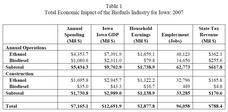British Columbia launches Bioenergy Strategy: electricity self sufficiency with biomass, zero GHG emissions from power, 50% biofuels by 2020
 British Columbia's govrnment announced the launch of the province's comprehensive Bioenergy Strategy [*.pdf]. The framework aims to make the Canadian province entirely electricity self-sufficient by 2016 by relying on biomass. The emphasis on bioenergy will also lead to meeting the target of achieving zero new emissions from energy generation projects. Moreover, bioenergy and biofuels are to make up 50 per cent of all renewable fuels in the province by 2020.
British Columbia's govrnment announced the launch of the province's comprehensive Bioenergy Strategy [*.pdf]. The framework aims to make the Canadian province entirely electricity self-sufficient by 2016 by relying on biomass. The emphasis on bioenergy will also lead to meeting the target of achieving zero new emissions from energy generation projects. Moreover, bioenergy and biofuels are to make up 50 per cent of all renewable fuels in the province by 2020.The plan covers investments over the coming decennium into the broadest range of bioenergy sectors: bio-electricity, bioproducts, organic waste-to-energy, next-generation liquid biofuels such as cellulosic ethanol and gasification based biofuels, biohydrogen and biogas (timeline, click to enlarge).
According to the government, the Bioenergy Strategy will create new opportunities for rural communities; spur new investment and innovation; help British Columbia reach the goal of achieving full energy security, and help it fight climate change in a drastic way.
The BC Bioenergy Strategy includes:
- Establishment of $25 million in funding for a provincial Bioenergy Network for greater investment and innovation in B.C. bioenergy projects and technologies
- A target for B.C biofuel production to meet 50 per cent or more of the province’s renewable fuel requirements by 2020, which supports the reduction of greenhouse gas emissions from transportation
- The establishment of funding to advance provincial biodiesel production with up to $10 million over three years
- Development of at least 10 community energy projects that convert local biomass into energy by 2020
- Issuing a two-part Bioenergy Call for Power – the first part will be issued shortly, the second part by July 1, 2008 – focusing on existing biomass inventory in the forest industry and offering opportunities for smaller energy producers with projects that are immediately viable
- Establishment one of Canada’s most comprehensive provincial biomass inventories that creates waste to energy opportunities
- Support for methane capture from the province's largest landfills
- Incentives to utilize waste wood from phased-out beehive burners to produce clean energy
- Support for wood gasification research, development and commercialization
The proposed Bioenergy Network will:
- Support wood gasification research, development and commercialization in collaboration with the University of Northern British Columbia, University of British Columbia, Forest Products Innovation, the National Research Council, the forestry and energy sectors, industry and other partners.
- Advance biorefining for multiple, value-added product streams, such as biochemicals, in conjunction with bioenergy production in new facilities and/or at existing industrial operations by working with the BC Bioproducts Association, First Nations, agricultural and forest sectors.
- Encourage the development of pilot and demonstration projects with industries and communities in key biomass resource areas.
- Support research into socially and environmentally responsible dedicated energy crop production and enhance enzymatic and other biotechnology solutions for biomass-to-energy conversion.
- Advance the development of biofuels, such as cellulosic ethanol and renewable diesel from algae and other resources, through the Green Energy and Environmentally Friendly Chemical Technologies Project and other initiatives.
 energy :: sustainability :: biomass :: bioenergy :: biofuels :: biohydrogen :: biogas :: bio-electricity :: bioproducts :: renewable :: emissions :: British Columbia :: Canada ::
energy :: sustainability :: biomass :: bioenergy :: biofuels :: biohydrogen :: biogas :: bio-electricity :: bioproducts :: renewable :: emissions :: British Columbia :: Canada :: The network will strengthen the development of world-class bioenergy research and technology expertise in British Columbia. This will include the creation of at least one academic leadership chair in bioenergy.
There is an abundance of bioenergy opportunities, such as using biomass created out of the mountain pine beetle outbreak that can stimulate investment and economic diversification while producing clean energy. - Gordon Campbell, British Columbia's PremierAdditionally, the bioenergy strategy will help facilitate the closure of beehive burners and divert the waste stream for energy production, increase production and utilization of biofuels including biodiesel and facilitate production of anaerobic digestion bioenergy to address waste anagement
B.C. has half of Canada’s entire biomass electricity-generating capacity. This strategy helps forest-dependent communities and brings opportunity to the agriculture sector as it looks at recovering maximum value from beetle-killed timber, wood wastes, and agricultural residues to generate renewable energy. - Rich Coleman, Forests and Range Minister
challenges posed by the agricultural industry. The Province will also work with industry to develop new fine particulate standards for industrial boilers to improve air quality.
B.C. leads Canada in energy production from biomass. Over 800 megawatts of biomass electricity capacity is installed in the province, enough to power 640,000 households. Pulp and paper mills meet over a third of their electricity needs through cogeneration of electricity and steam on site. In 2007, the B.C. wood pellet industry produced over 900,000 tonnes of wood pellets, of which 90 per cent was exported for thermal power production overseas.
Encouraging the emerging bioenergy industry and developing new and innovative uses for beetle-wood is part of the provincial Mountain Pine Beetle Action Plan.
References:
British Columbia, Office of the Premier, Ministry of Energy, Mines and Petroleum Resources, Ministry of Forests and Range: New Bioenergy Strategy Advances Innovation - January 31, 2008.
British Columbia Energy Plan: British Columbia Bioenergy Strategy [*.pdf].
British Columbia Energy Plan: Bioenergy Information Guide [*.pdf].
Article continues
 --------------
--------------
 The 4th Annual Brussels Climate Change Conference is announced for 26 - 27 February 2008. This joint CEPS/Epsilon conference will explore the key issues for a post-Kyoto agreement on climate change. The conference focuses on EU and global issues relating to global warming, and in particular looks at the following issues: - Post-2012 after Bali and before the Hokkaido G8 summit; Progress of EU integrated energy and climate package, burden-sharing renewables and technology; EU Emissions Trading Review with a focus on investment; Transport
The 4th Annual Brussels Climate Change Conference is announced for 26 - 27 February 2008. This joint CEPS/Epsilon conference will explore the key issues for a post-Kyoto agreement on climate change. The conference focuses on EU and global issues relating to global warming, and in particular looks at the following issues: - Post-2012 after Bali and before the Hokkaido G8 summit; Progress of EU integrated energy and climate package, burden-sharing renewables and technology; EU Emissions Trading Review with a focus on investment; Transport










Friday, February 01, 2008
A380 test flight on GTL fuel kicks off Airbus alternative fuel program - includes biofuels
The A380, today’s most fuel efficient airliner, is powered by Rolls Royce Trent 900 engines. Shell International Petroleum provided the Shell GTL Jet Fuel. The tests are running in parallel to the agreement signed in November 2007 with the Qatar GTL consortium partners and the results will be shared.
The A380 was chosen because the aircraft is already the environmental benchmark in air travel. It has four engines including segregated fuel tanks making it ideal for engine shut down and re-light tests under standard evaluation conditions. During the flight, engine number one was fed with a blend of GTL and jet fuel whilst the remaining three were fed with standard jet fuel.
This test flight initiates Airbus’ alternatives fuels research programme. GTL could be available at certain locations to make it a practical and viable drop-in alternative fuel for commercial aviation in the short term. GTL has attractive characteristics for local air quality, as well as some benefits in terms of aircraft fuel burn relative to existing jet fuel. For instance, it is virtually free of sulphur. Synthetic fuel can be made from a range of hydrocarbon source material including natural gas or biomass, via the Fischer-Tropsch process.
Testing GTL today will support future second generation biofuels, but which are not presently available in sufficient commercial quantities. Airbus says it will study viable second generation biofuels when they become available:
Airbus's trial comes at a time when Virgin Atlantic is expected to test the world's first large civilian aircraft on biofuel. It announced the test flight will take place this month. The aircraft will be a Boeing 747. Virgin has not disclosed which biofuel it will be utilizing on that historic occasion.
With Airbus' test flight today and its announcement that it too will research next-generation biofuels, all major aircraft manufacturers (Airbus, Boeing, Embraer and others) now have initiated programs to research renewable biofuels for aviation.
In December, the United States Air Force conducted the first ever transcontinental flight of a large aircraft - a C17 - on a synthetic fuel. The flight followed successful tests of the fuel blend in C-17 engines in October, and was the next step in the Air Force's effort to have its entire C-17 fleet certified to use the mixture. Air Force officials certified B-52 Stratotankers to use the mixture in August, and hope to certify the fuel blend for use in all its aircraft within the next five years (previous post).
References:
EADS: Airbus Completes First Test Flight With Alternative Fuel On Civil Aircraft - February 1, 2008.
EADS: Airbus A380 Commences Alternative Fuel Test Flight Programme - February 1, 2008.
Biopact: USAF C-17 makes first ever transcontinental flight on synthetic fuel blend - December 18, 2007
Biopact: Virgin Atlantic to test biofuel in 747 in early 2008 - October 16, 2007
Article continues
posted by Biopact team at 10:42 PM 0 comments links to this post
